Experimental Analysis and Parametric Optimization on Compressive Properties of Diamond-Reinforced Porous Al Composites
Abstract
:1. Introduction
2. Methodology
2.1. Experimental Procedure
2.1.1. Preparation of Porous Al Composites
2.1.2. Characterization and Testing
2.2. Design of Experiments (DOE)
Taguchi’s L9 Orthogonal Array
3. Results and Discussion
3.1. Morphological Analysis
3.2. Effect of Sintering Temperature
3.3. Effect of Compaction Pressure
3.4. Effect of Sintering Time
3.5. Analysis of Signal-to-Noise (S/N) Ratio
3.6. Analysis of Variance (ANOVA)
3.7. Regression Analysis
3.8. Response Optimization
3.9. Contour Plot
3.10. Confirmation Test
4. Conclusions
Author Contributions
Funding
Institutional Review Board Statement
Informed Consent Statement
Data Availability Statement
Acknowledgments
Conflicts of Interest
References
- Parveez, B.; Jamal, N.A.; Anuar, H.; Ahmad, Y.; Aabid, A.; Baig, M. Microstructure and Mechanical Properties of Metal Foams Fabricated via Melt Foaming and Powder Metallurgy Technique: A Review. Materials 2022, 15, 5302. [Google Scholar] [CrossRef] [PubMed]
- Space, N.; Noh, R.; Razali, M.; Abdullah, B.; Ismail, M.H. Mechanical Properties of Aluminium Foam by Conventional Casting Mechanical Properties of Aluminium Foam by Conventional Casting Combined with NaCl Space Holder. Appl. Mech. Mater. 2013, 393, 156–160. [Google Scholar] [CrossRef]
- Ozer, G. Cellular Aluminium Foam Metal Production with Space Holder Particles. Mater. Test. 2010, 52, 379–382. [Google Scholar] [CrossRef]
- Moradi, M.R.; Moloodi, A.; Habibolahzadeh, A. Fabrication of Nano-composite Al-B 4 C Foam via Powder Metallurgy-Space Holder Technique. Procedia Mater. Sci. 2015, 11, 553–559. [Google Scholar] [CrossRef] [Green Version]
- Shunmugasamy, V.C.; Mansoor, B. Cellular Magnesium Matrix Foam Composites for Mechanical Damping Applications. JOM 2016, 68, 279–287. [Google Scholar] [CrossRef]
- Aida, S.F.; Zuhailawati, H.; Anasyida, A.S. The Effect of Space Holder Content and Sintering Temperature of Magnesium Foam on Microstructural and Properties Prepared by Sintering Dissolution Process ( SDP ) using Carbamide Space Holder. Procedia Eng. 2017, 184, 290–297. [Google Scholar] [CrossRef]
- Jakubowicz, J.; Adamek, G.; Dewidar, M. Titanium foam made with saccharose as a space holder Titanium foam made with saccharose as a space holder. J. Porous Mater. 2013, 20, 1137–1141. [Google Scholar] [CrossRef] [Green Version]
- Smorygo, O. High-porosity titanium foams by powder coated space holder compaction method. Mater. Lett. 2012, 83, 17–19. [Google Scholar] [CrossRef]
- Mechanics, A.; Tun, U.; Onn, H.; Jamaludin, K.R.; Hussin, R.; Tun, U.; Onn, H.; Ismail, A.; Tun, U.; Onn, H. Potassium Bromide as Space Holder for Titanium Foam Preparation. In Applied Mechanics and Materials; Trans Tech Publications Ltd.: Stafa-Zurich, Switzerland, 2014. [Google Scholar] [CrossRef]
- Parveez, B.; Jamal, N.A.; Maleque, A.; Yusof, F.; Jamadon, N.H.; Adzila, S. Review on advances in porous Al composites and the possible way forward. J. Mater. Res. Technol. 2021, 14, 2017–2038. [Google Scholar] [CrossRef]
- Hamdi, A.A. Effect of Magnesium and Tin as Sintering Additives on Microstructure and Compressive Properties of Porous Aluminum. Master's Thesis, Universiti Sains Malaysia, Penang, Malaysia, August 2018. [Google Scholar]
- Sercombe, T.B. Non-Conventional Sintered Aluminium Powder Alloys. Ph.D. Thesis, The University of Queensland, Brisbane, Australia, 1998. [Google Scholar]
- Jamal, N.A.; Yusof, F.; Nor, Y.A.; Othman, M.; Khalid, K.; Zakaria, M.N. The role of tin and magnesium in assisting liquid phase sintering of aluminum (Al). IOP Conf. Ser. Mater. Sci. Eng. 2018, 290, 012008. [Google Scholar] [CrossRef]
- Ali, S.; Rani, A.M.A.; Altaf, K.; Baig, Z. Investigation of Boron addition and compaction pressure on the compactibility, densification and microhardness of 316L Stainless Steel. IOP Conf. Ser. Mater. Sci. Eng. 2018, 344, 012023. [Google Scholar] [CrossRef] [Green Version]
- Kontis, P.; Yusof, H.A.M.; Pedrazzini, S.; Danaie, M.; Moore, K.L.; Bagot, P.A.J.; Moody, M.P.; Grovenor, C.R.M.; Reed, R.C. On the effect of boron on grain boundary character in a new polycrystalline superalloy. Acta Mater. 2016, 103, 688–699. [Google Scholar] [CrossRef]
- Chung, C.Y.; Chu, C.H.; Lee, M.T.; Lin, C.M.; Lin, S.J. Effect of titanium addition on the thermal properties of diamond/Cu-Ti composites fabricated by pressureless liquid-phase sintering technique. Sci. World J. 2014, 2014, 713537. [Google Scholar] [CrossRef] [Green Version]
- Luo, Y.; Yu, S.; Liu, J.; Zhu, X.; Luo, Y. Compressive property and energy absorption characteristic of open-cell SiCp/AlSi9Mg composite foams. J. Alloy. Compd. 2010, 499, 227–230. [Google Scholar] [CrossRef]
- Alizadeh, M.; Mirzaei-Aliabadi, M. Compressive properties and energy absorption behavior of Al-Al2O3 composite foam synthesized by space-holder technique. Mater. Des. 2012, 35, 419–424. [Google Scholar] [CrossRef]
- Prabhu, B.; Suryanarayana, C.; An, L.; Vaidyanathan, R. Synthesis and characterization of high volume fraction Al-Al2O3 nanocomposite powders by high-energy milling. Mater. Sci. Eng. A 2006, 425, 192–200. [Google Scholar] [CrossRef]
- Yang, K.; Yang, X.; He, C.; Liu, E.; Shi, C.; Ma, L.; Li, Q.; Li, J.; Zhao, N. Damping characteristics of Al matrix composite foams reinforced by in-situ grown carbon nanotubes. Mater. Lett. 2017, 209, 68–70. [Google Scholar] [CrossRef]
- Yang, X.; Hu, Q.; Li, W.; Song, H.; Zou, T.; Zong, R.; Sha, J.; He, C.; Zhao, N. Compression-compression fatigue performance of aluminium matrix composite foams reinforced by carbon nanotubes. Fatigue Fract. Eng. Mater. Struct. 2020, 43, 744–756. [Google Scholar] [CrossRef]
- Wang, J.; Yang, X.; Zhang, M.; Li, J.; Shi, C.; Zhao, N.; Zou, T. A novel approach to obtain in-situ growth carbon nanotube reinforced aluminum foams with enhanced properties. Mater. Lett. 2015, 161, 763–766. [Google Scholar] [CrossRef]
- Elbir, S.; Yilmaz, S.; Toksoy, A.K.; Guden, M.; Hall, I.W. SiC-particulate aluminum composite foams produced by powder compacts: Foaming and compression behavior. J. Mater. Sci. 2003, 38, 4745–4755. [Google Scholar] [CrossRef] [Green Version]
- Salehi, A.; Babakhani, A.; Zebarjad, S.M. Microstructural and mechanical properties of Al-SiO2 nanocomposite foams produced by an ultrasonic technique. Mater. Sci. Eng. A 2015, 638, 54–59. [Google Scholar] [CrossRef]
- Guden, M.; Yüksel, S. SiC-particulate aluminum composite foams produced from powder compacts: Foaming and compression behavior. J. Mater. Sci. 2006, 41, 4075–4084. [Google Scholar] [CrossRef] [Green Version]
- Daoud, A. Compressive response and energy absorption of foamed A359–Al2O3 particle composites. J. Alloy. Compd. 2009, 486, 597–605. [Google Scholar] [CrossRef]
- Krishnan, A.; Dujardin, E.; Ebbesen, T. Young’s modulus of single-walled nanotubes. Phys. Rev. B—Condens. Matter Mater. Phys. 1998, 58, 14013–14019. [Google Scholar] [CrossRef] [Green Version]
- Yang, X.; Shi, C.; He, C.; Liu, E.; Li, J.; Zhao, N. Synthesis of uniformly dispersed carbon nanotube reinforcement in Al powder for preparing reinforced Al composites. Compos. Part A Appl. Sci. Manuf. 2011, 42, 1833–1839. [Google Scholar] [CrossRef]
- Esawi, A.M.K.; Morsi, K.; Sayed, A.; Taher, M.; Lanka, S. Effect of carbon nanotube (CNT) content on the mechanical properties of CNT-reinforced aluminium composites. Compos. Sci. Technol. 2010, 70, 2237–2241. [Google Scholar] [CrossRef]
- Ogawa, F.; Yamamoto, S.; Masuda, C. Strong, ductile, and thermally conductive carbon nanotube-reinforced aluminum matrix composites fabricated by ball-milling and hot extrusion of powders encapsulated in aluminum containers. Mater. Sci. Eng. A 2018, 711, 460–469. [Google Scholar] [CrossRef]
- Banerjee, S.; Hemraj-Benny, T.; Wong, S.S. Covalent surface chemistry of single-walled carbon nanotubes. Adv. Mater. 2005, 17, 17–29. [Google Scholar] [CrossRef]
- Damanik, F.S.; Damanik, M.S.F.; Lange, P.G. Effect of Nickel Coated of Carbon Fiber on Distribution of Carbon Fiber Reinforced Aluminium ( AlSi7 ) Foam Composite by Powder Metallurgy. In Proceedings of the International Conference on Innovative Technologies, Belgrade, Serbia, 11–13 September 2019; pp. 9–13. [Google Scholar]
- Aboraia, M.; Sharkawi, R.; Doheim, M.A. Production of aluminium foam and the effect of calcium carbonate as a foaming agent. J. Eng. Sci. 2011, 39, 441–451. [Google Scholar] [CrossRef]
- Nakamura, T.; Gnyloskurenko, S.V.; Sakamoto, K.; Byakova, A.V.; Ishikawa, R. Development of new foaming agent for metal foam. Mater. Trans. 2002, 43, 1191–1196. [Google Scholar] [CrossRef] [Green Version]
- Mukherjee, M.; García-Moreno, F.; Jiménez, C.; Rack, A.; Banhart, J. Microporosity in aluminium foams. Acta Mater. 2017, 131, 156–168. [Google Scholar] [CrossRef]
- Jiang, B.; Wang, Z.; Zhao, N. Effect of pore size and relative density on the mechanical properties of open cell aluminum foams. Scr. Mater. 2007, 56, 169–172. [Google Scholar] [CrossRef]
- Yang, X.; Hu, Q.; Du, J.; Song, H.; Zou, T.; Sha, J.; He, C.; Zhao, N. Compression fatigue properties of open-cell aluminum foams fabricated by space-holder method. Int. J. Fatigue 2019, 121, 272–280. [Google Scholar] [CrossRef]
- French, A.D. Idealized powder diffraction patterns for cellulose polymorphs. Cellulose 2014, 21, 885–896. [Google Scholar] [CrossRef]
- Jamal, N.A.; Tan, A.W.; Yusof, F.; Katsuyoshi, K.; Hisashi, I.; Singh, S.; Anuar, H. Fabrication and compressive properties of low to medium porosity closed-cell porous Aluminum using PMMA space holder technique. Materials 2016, 9, 254. [Google Scholar] [CrossRef] [Green Version]
- Tan, P.P.; Mohamad, H.; Anasyida, A.S. Properties of Porous Magnesium Using Polymethyl Methacrylate (PMMA) as a Space Holder. J. Phys. Conf. Ser. 2018, 1082, 012063. [Google Scholar] [CrossRef]
- Hassan, Z.K. Production of metal foams by using powder metallurgy method. AIP Conf. Proc. 2019, 2123, 020004. [Google Scholar]
- Kumar, S.; Madurai, R.C. Optimization of powder metallurgy parameters of TiC and B4C reinforced aluminium composites by Taguchi method. Trans. Can. Soc. Mech. Eng. 2020, 45, 249–261. [Google Scholar]
- Surace, R.; De Filippis, L.A.C.; Ludovico, A.D.; Boghetich, G. Influence of processing parameters on aluminium foam produced by space holder technique. Mater. Des. 2009, 30, 1878–1885. [Google Scholar] [CrossRef]
- Küçük, Ö.; Taher, T.; Elfarah, K.; Islak, S.; Özorak, C. Optimization by Using Taguchi Method of the Production of Magnesium-Matrix Carbide Reinforced. Metals 2017, 7, 352. [Google Scholar] [CrossRef] [Green Version]
- Hassani, A.; Habibolahzadeh, A.; Bafti, H. Production of graded aluminum foams via powder space holder technique. Mater. Des. 2012, 40, 510–515. [Google Scholar] [CrossRef]
- Baumeister, J.; Banhart, J.; Weber, M. Aluminium foams for transport industry. Mater. Des. 1997, 18, 217–220. [Google Scholar] [CrossRef]
- Jankovic, A.; Chaudhary, G.; Goia, F. Designing the design of experiments (DOE)—An investigation on the influence of different factorial designs on the characterization of complex systems. Energy Build. 2021, 250, 111298. [Google Scholar] [CrossRef]
- Tang, F.; Fudouzi, H.; Uchikoshi, T.; Sakka, Y. Preparation of porous materials with controlled pore size and porosity. J. Eur. Ceram. Soc. 2004, 24, 341–344. [Google Scholar] [CrossRef]
- Michailidis, N.; Tsouknidas, A.; Lefebvre, L.P.; Hipke, T.; Kanetake, N. Production, characterization, and applications of porous materials. Adv. Mater. Sci. Eng. 2014, 2014, 2–4. [Google Scholar] [CrossRef] [Green Version]
- Finkelstein, A.; Schaefer, A.; Dubinin, N. Aluminum alloy selection for in situ composite production by oxygen blowing. Metals 2021, 11, 1984. [Google Scholar] [CrossRef]
- Vogel, T.; Ma, S.; Liu, Y.; Guo, Q.; Zhang, D. Impact of alumina content and morphology on the mechanical properties of bulk nanolaminated Al2O3-Al composites. Compos. Commun. 2020, 22, 100462. [Google Scholar] [CrossRef]
- Arifvianto, B.; Zhou, J. Fabrication of metallic biomedical scaffolds with the space holder method: A review. Materials 2014, 7, 3588–3622. [Google Scholar] [CrossRef] [Green Version]
- Jamal, N.A.; Maizatul, O.; Anuar, H.; Yusof, F.; Nor, Y.A.; Khalid, K.; Zakaria, M.N. Preliminary development of porous aluminum via powder metallurgy technique. Mater. Werkst. 2018, 49, 460–466. [Google Scholar] [CrossRef]
- Zhao, Y.; Han, F.; Fung, T. Optimisation of compaction and liquid-state sintering in sintering and dissolution process for manufacturing A1 foams. Mater. Sci. Eng. A 2004, 364, 117–125. [Google Scholar] [CrossRef] [Green Version]
- Li, B.Q.; Wang, C.Y.; Lu, X. Effect of pore structure on the compressive property of porous Ti produced by powder metallurgy technique. Mater. Des. 2013, 50, 613–619. [Google Scholar] [CrossRef]
- Manonukul, A.; Muenya, N.; Léaux, F.; Amaranan, S. Effects of replacing metal powder with powder space holder on metal foam produced by metal injection moulding. J. Mater. Process. Technol. 2010, 210, 529–535. [Google Scholar] [CrossRef]
- Aida, S.F.; Hijrah, M.N.; Amirah, A.H.; Zuhailawati, H.; Anasyida, A.S. Effect of NaCl as a Space Holder in Producing Open Cell A356 Aluminium Foam by Gravity Die Casting Process. Procedia Chem. 2016, 19, 234–240. [Google Scholar] [CrossRef] [Green Version]
- Arifvianto, B. Synthesis and Evaluation of Porous Titanium Scaffolds Prepared with the Space Holder Method for Bone Tissue Engineering. Ph.D. Thesis, Delft University of Technology, Delft, Netherlands, 2017. [Google Scholar]
- Almomani, M.A.; Shatnawi, A.M.; Alrashdan, M.K. Effect of Sintering Time on the Density, Porosity Content and Microstructure of Copper—1 wt. % Silicon Carbide Composites. Adv. Mater. Res. 2014, 1064, 32–37. [Google Scholar] [CrossRef]
- Tatt, T.K.; Muhamad, N.; Muchtar, A.; Sulong, A.B.; Cherng, N.M. Influence of sintering parameters on the compressive yield strength of stainless steel foams produced by the space holder method. Sains Malays. 2016, 45, 653–658. [Google Scholar]
- Manohar, G.; Pandey, K.M.; Ranjan Maity, S. Effect of compaction pressure on mechanical properties of AA7075/B4C/graphite hybrid composite fabricated by powder metallurgy techniques. Mater. Today Proc. 2020, 38, 2157–2161. [Google Scholar] [CrossRef]
- Hassanli, F.; Paydar, M.H. Improvement in energy absorption properties of aluminum foams by designing pore-density distribution. J. Mater. Res. Technol. 2021, 14, 609–619. [Google Scholar] [CrossRef]
- Aldoshan, A.; Khanna, S. Effect of relative density on the dynamic compressive behavior of carbon nanotube reinforced aluminum foam. Mater. Sci. Eng. A 2017, 689, 17–24. [Google Scholar] [CrossRef]
- Kováčik, J.; Nosko, M.; Mináriková, N.; Simančík, F.; Jerz, J. Closed-cell powder metallurgical aluminium foams reinforced with 3 vol.% sic and 3 vol.% graphite. Processes 2021, 9, 2031. [Google Scholar] [CrossRef]
- Yang, K.; Yang, X.; Liu, E.; Shi, C.; Ma, L.; He, C.; Li, Q.; Li, J.; Zhao, N. Elevated temperature compressive properties and energy absorption response of in-situ grown CNT-reinforced Al composite foams. Mater. Sci. Eng. A 2017, 690, 294–302. [Google Scholar] [CrossRef]

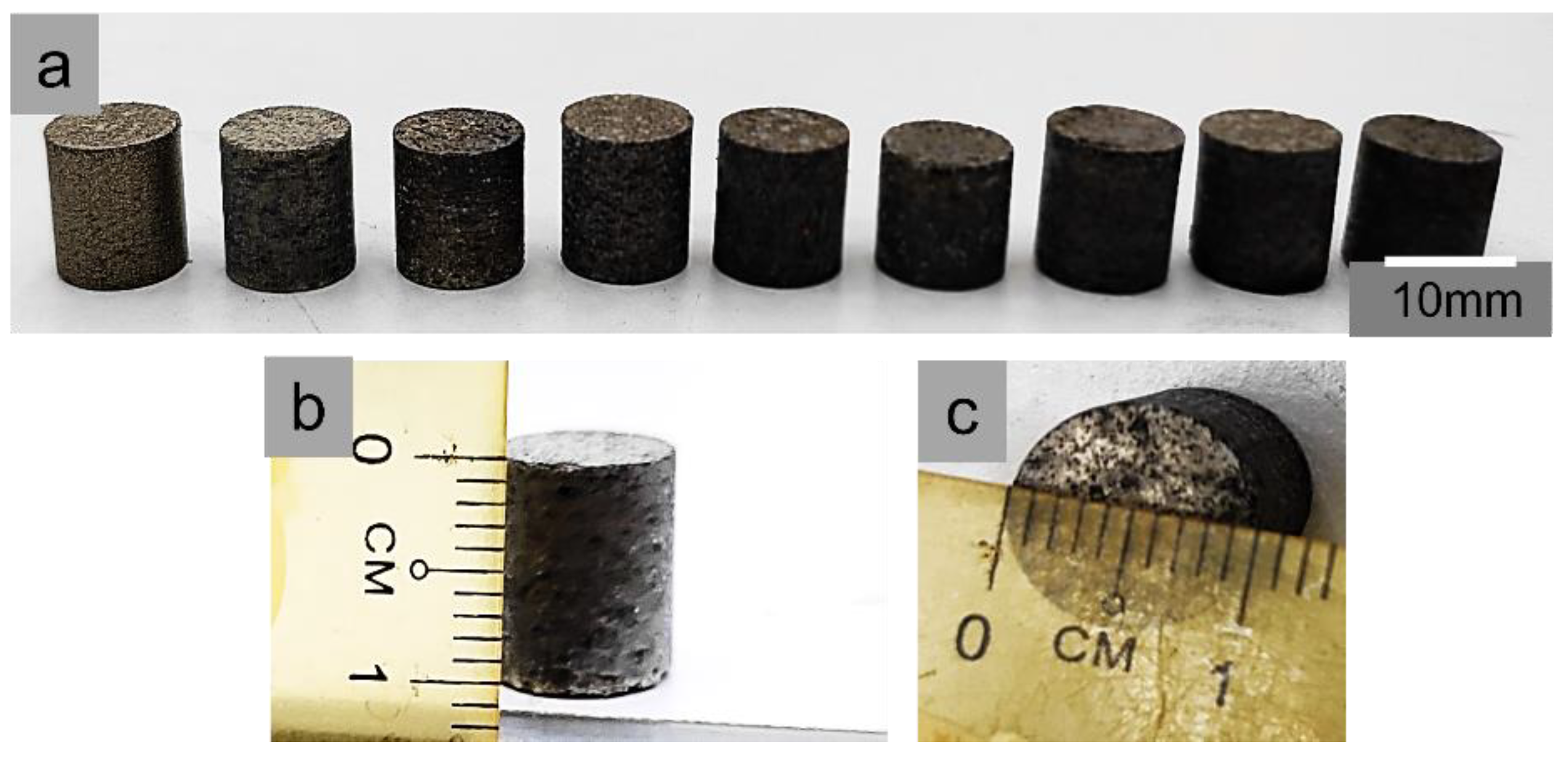
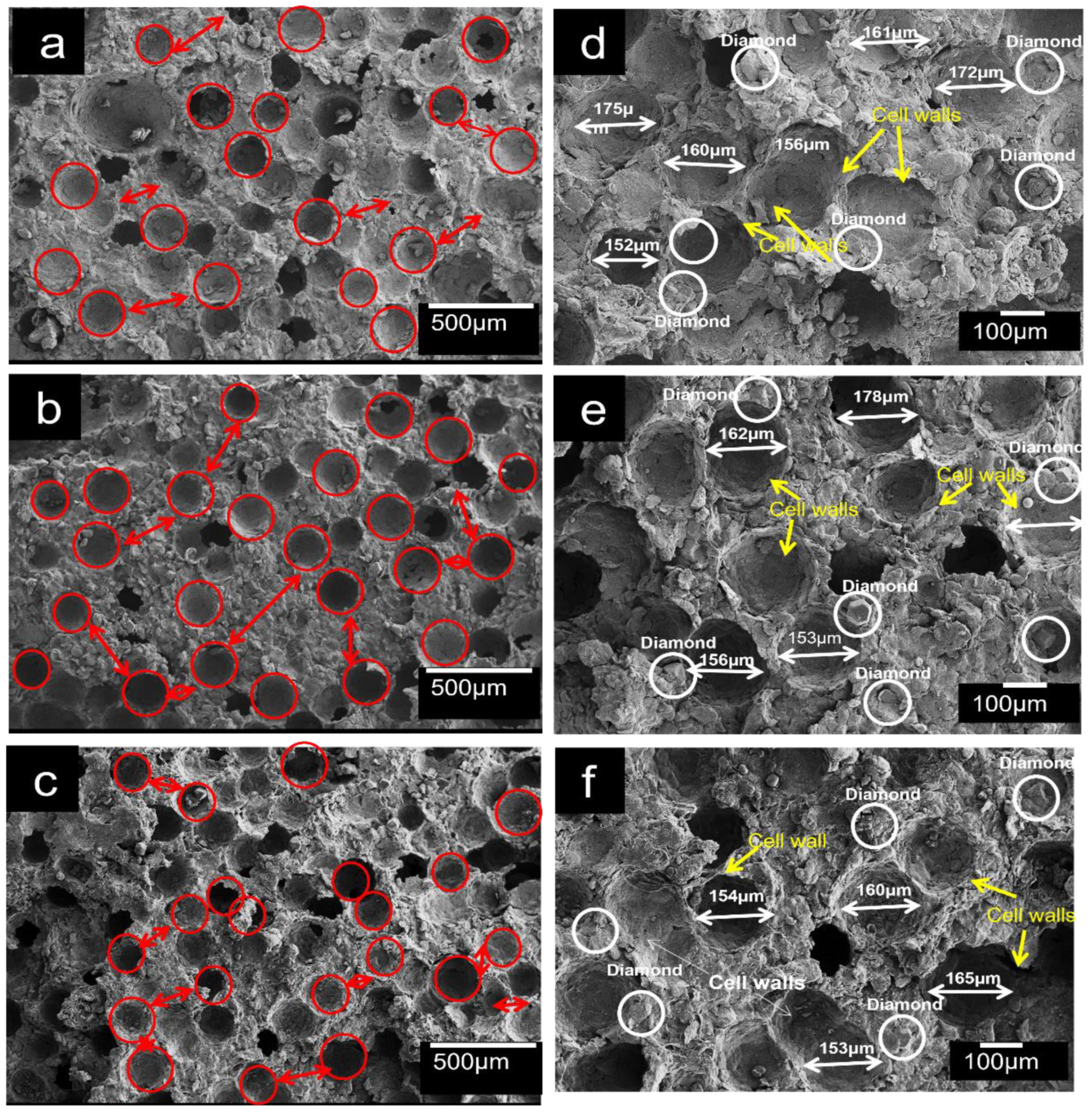
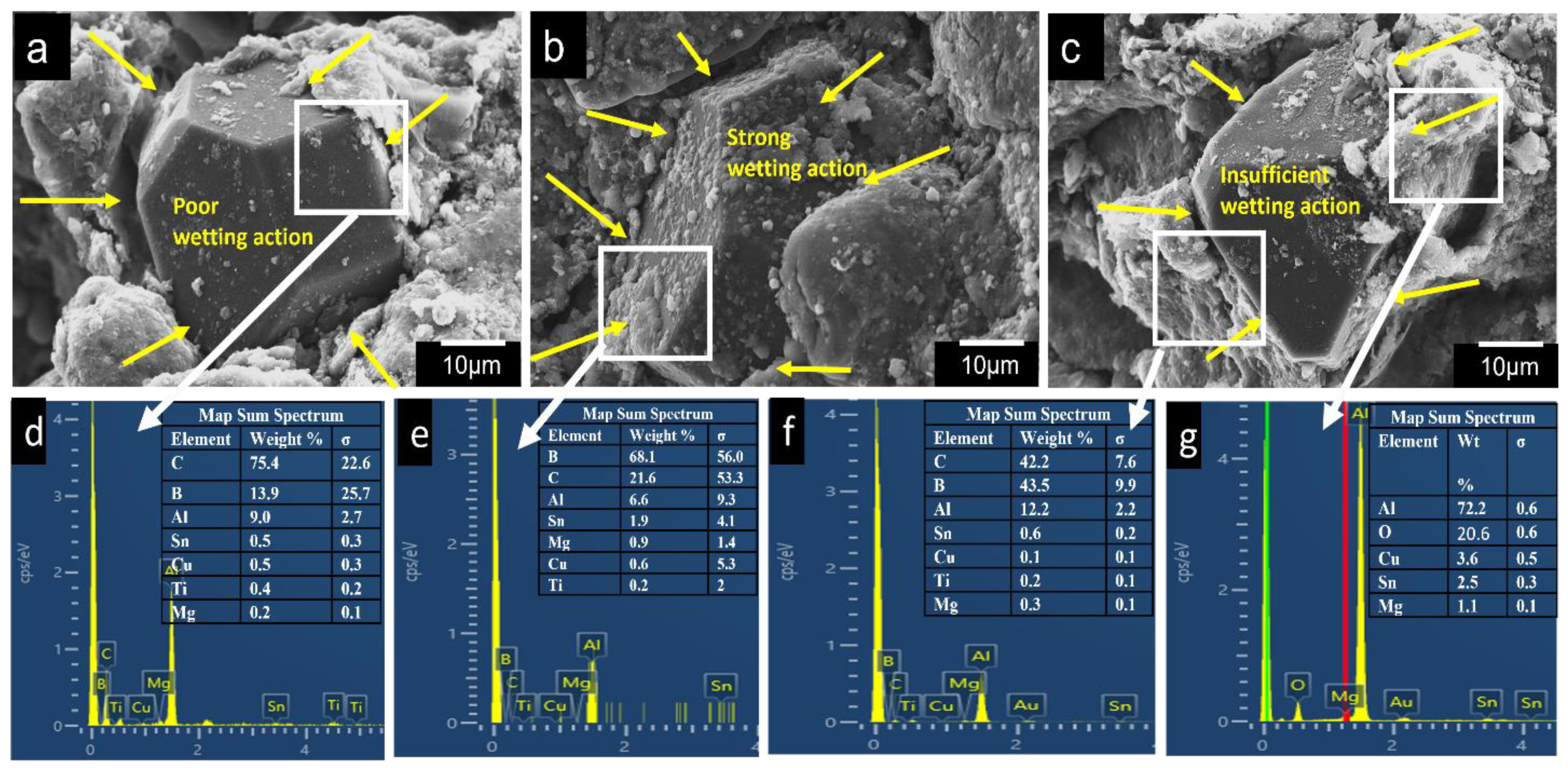
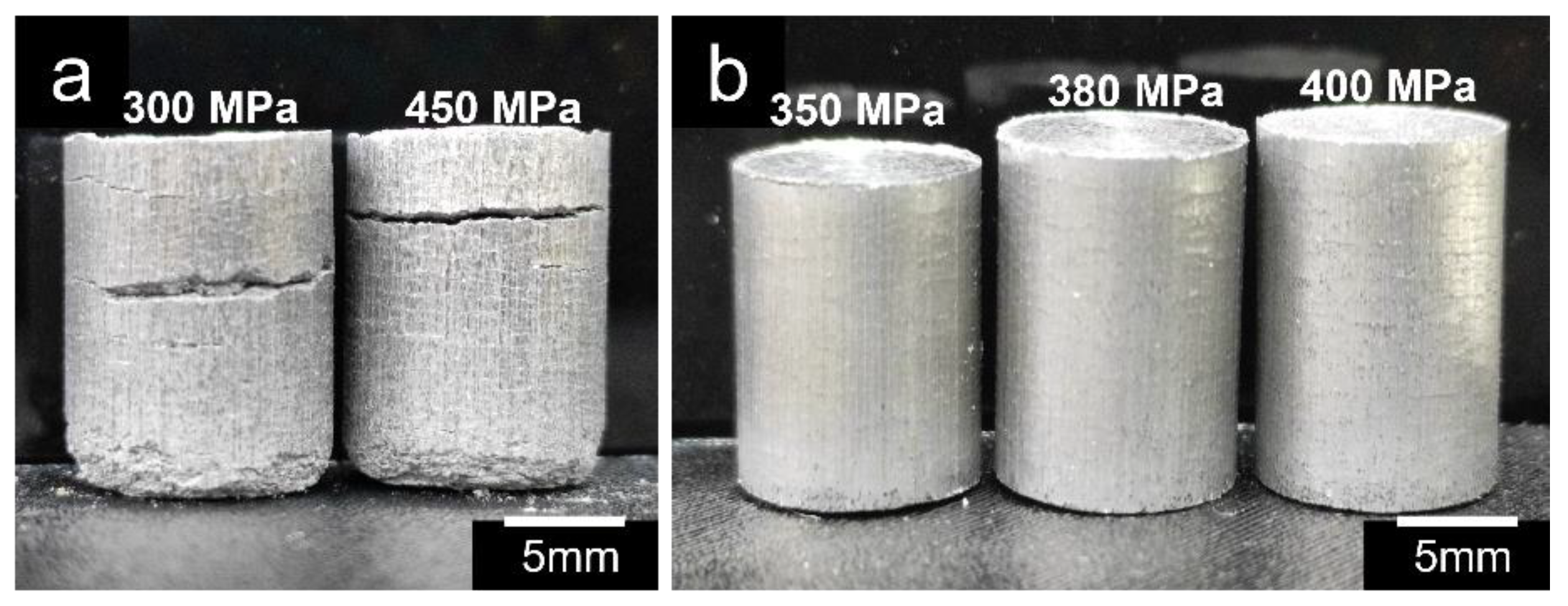
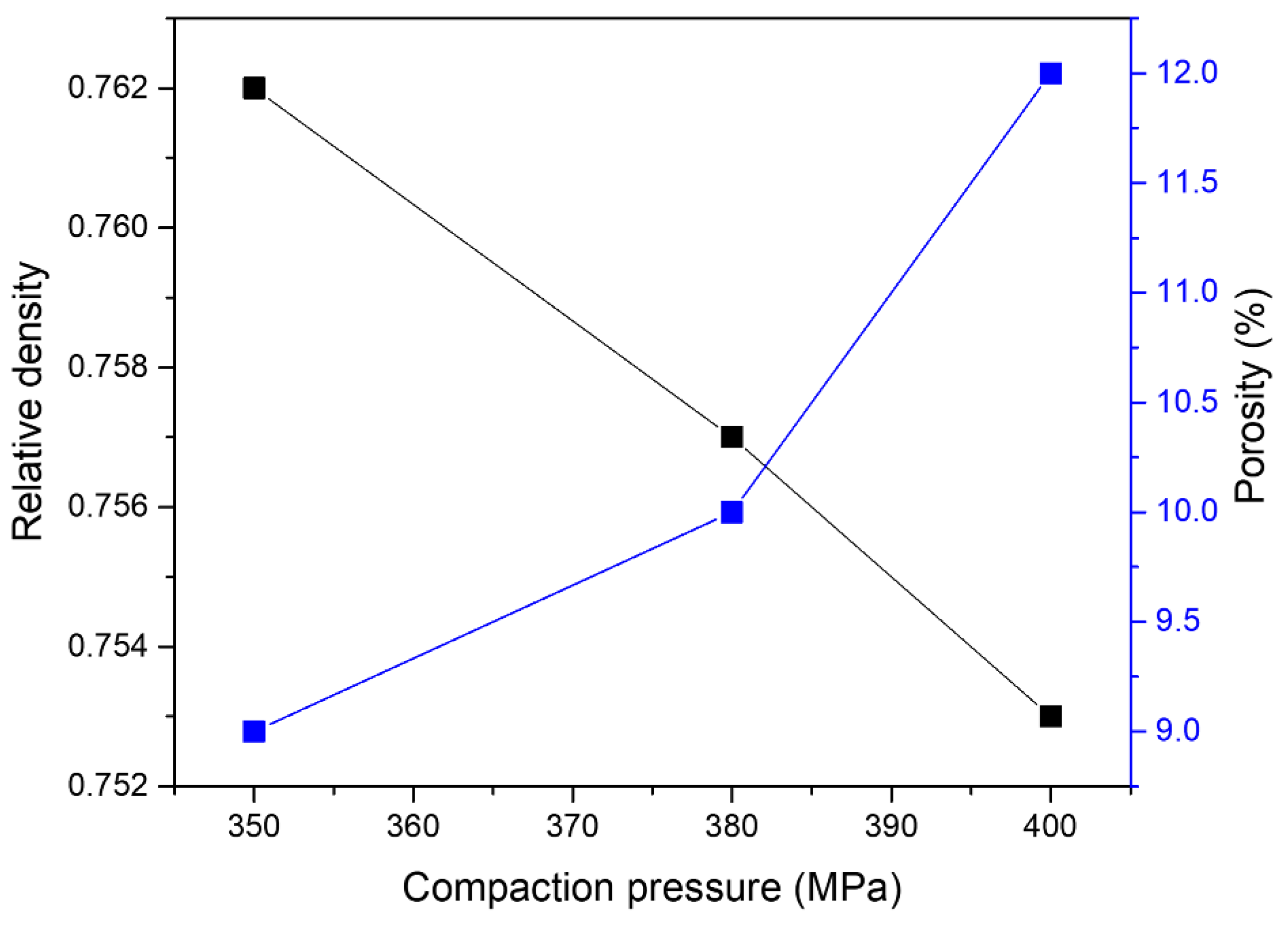


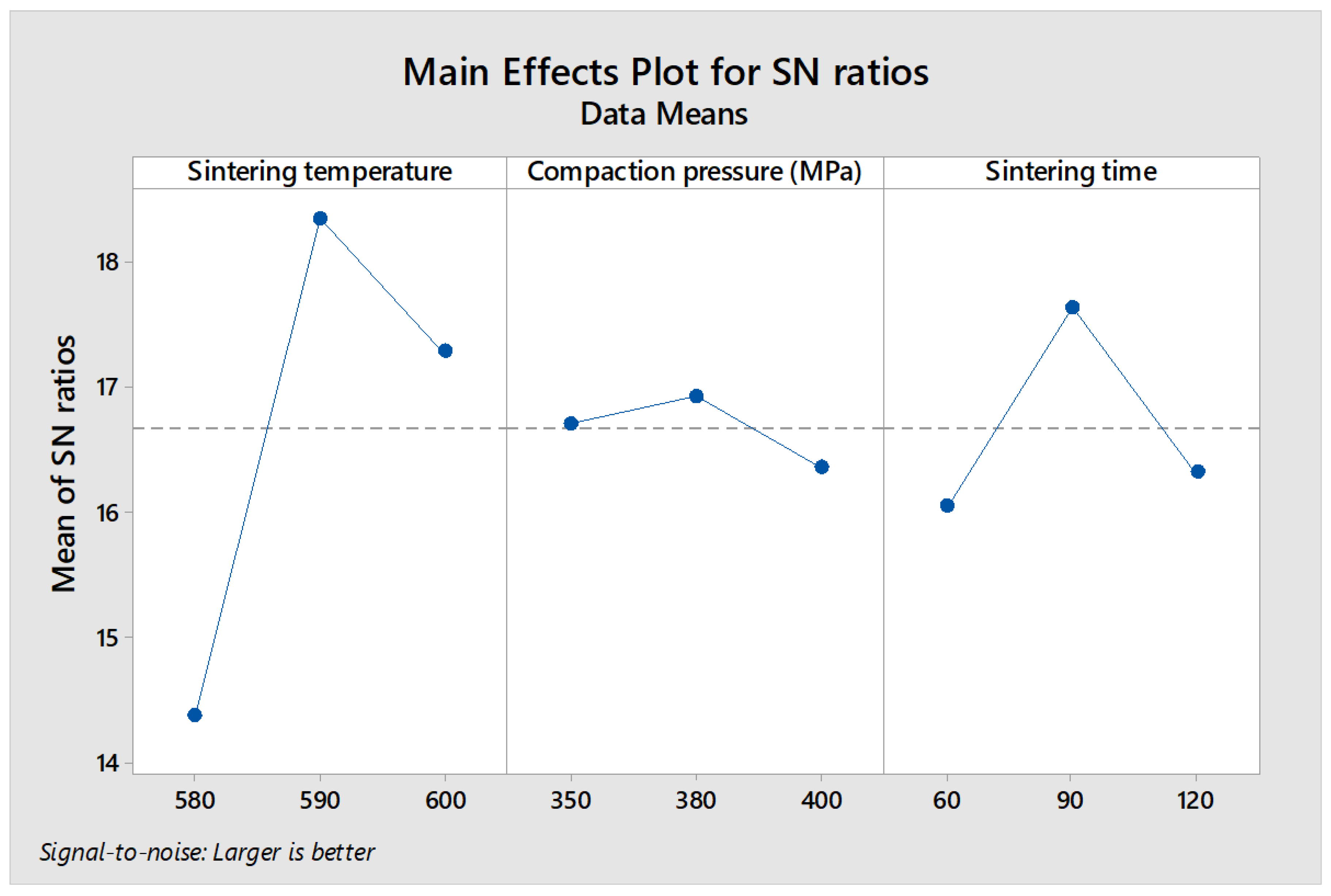



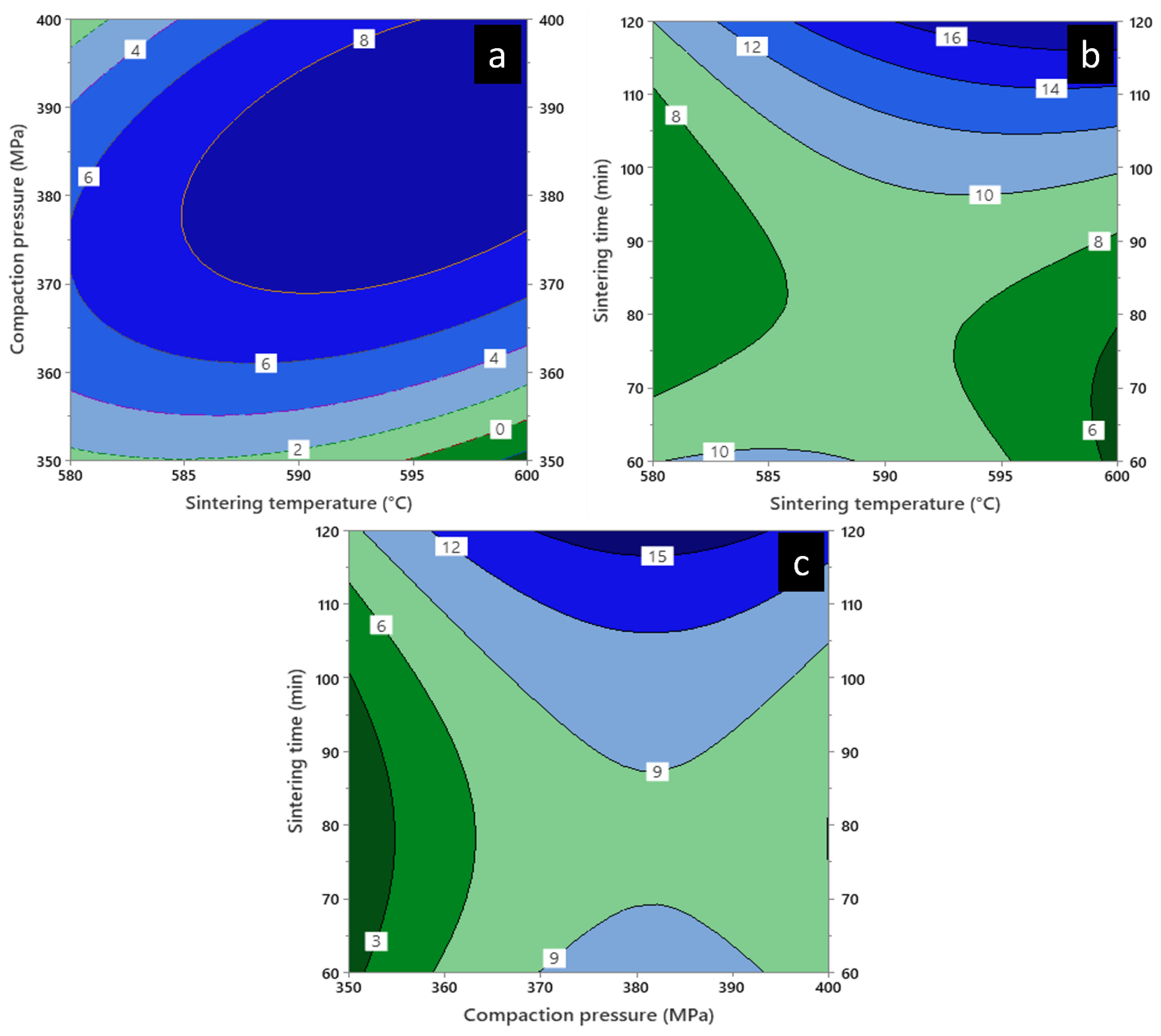
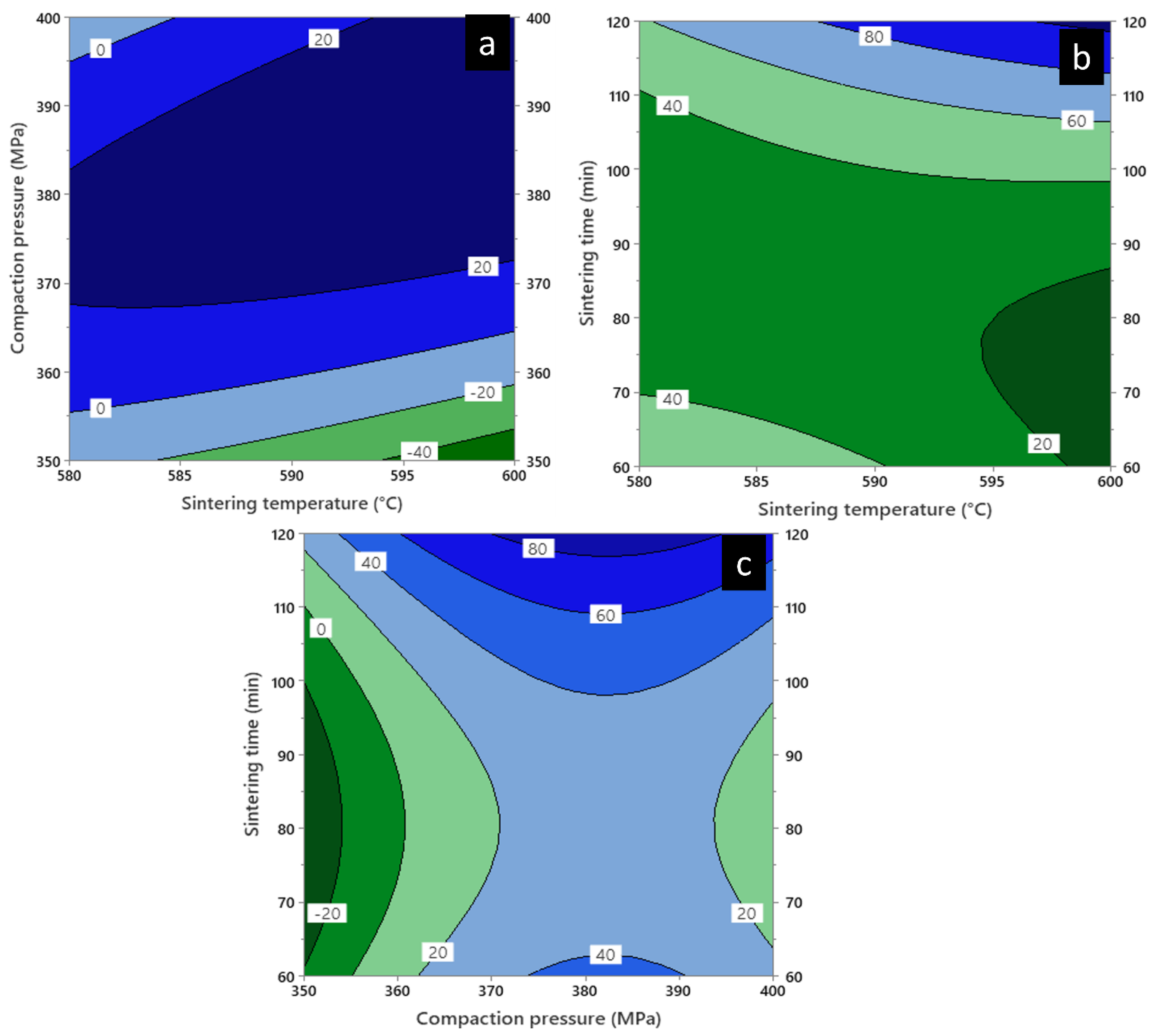
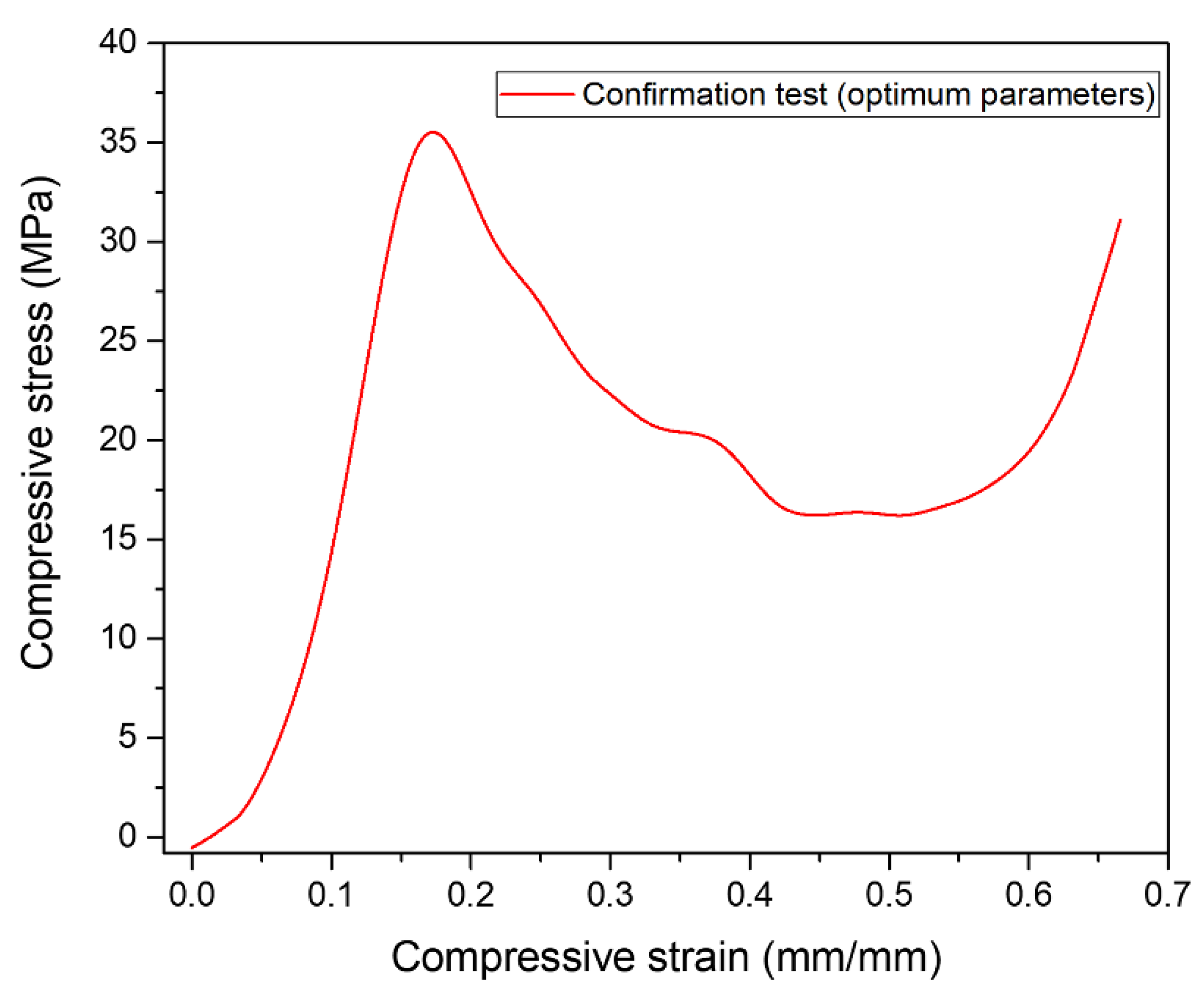
| Material | wt.% | Average Particle Size (µm) | Purity (%) |
|---|---|---|---|
| Alloy matrix | |||
| Al | 94 | 45 | 99.9 |
| Mg | 1 | 10 | 99.9 |
| Sn | 2 | 45 | 99.5 |
| Cu | 2 | 75 | 99.5 |
| B | 1 | 10 | 99.5 |
| Reinforcement | |||
| Ti-Diamond | 5 | 45 | 99.5 |
| Space holder | |||
| PMMA | 30 | 150 | 99.9 |
| Process | Parameters | |
|---|---|---|
| Mixing | Metallic mix (MM) | 300 rpm, 24 h |
| Mixing (MM + diamond) | 800 rpm, 2 h | |
| Mixing (MM + diamond + PMMA) | 800 rpm, 2 h | |
| Compaction Pressure | 350, 380, and 400 MPa | |
| Sintering temperature | 580, 590, and 600 °C | |
| Sintering time | 60, 90, and 120 min | |
| Factors | Symbol | Unit | Level 1 | Level 2 | Level 3 |
|---|---|---|---|---|---|
| Sintering temperature | A | °C | 580 | 590 | 600 |
| Compaction pressure | B | MPa | 350 | 380 | 400 |
| Sintering time | C | min | 60 | 90 | 120 |
| Runs | A | B | C | Plateau Stress (MPa) | Energy Absorption Capacity (Mj/m3) |
|---|---|---|---|---|---|
| 1 | 580 | 350 | 60 | 21.34 | 5.33 |
| 2 | 580 | 380 | 90 | 22.02 | 5.78 |
| 3 | 580 | 400 | 120 | 21.30 | 4.65 |
| 4 | 590 | 350 | 120 | 26.72 | 8.32 |
| 5 | 590 | 380 | 90 | 31.06 | 9.23 |
| 6 | 590 | 400 | 60 | 25.46 | 7.38 |
| 7 | 600 | 350 | 120 | 24.78 | 7.25 |
| 8 | 600 | 380 | 60 | 21.63 | 6.50 |
| 9 | 600 | 400 | 90 | 30.02 | 8.32 |
| S.No | 1 | 2 | 3 | 4 | 5 | 6 | 7 | 8 | 9 |
|---|---|---|---|---|---|---|---|---|---|
| Porosity (%) | 40 | 40 | 41 | 41 | 42 | 41 | 43 | 44 | 43 |
| Relative density | 0.83 | 0.81 | 0.80 | 0.86 | 0.84 | 0.86 | 0.84 | 0.83 | 0.84 |
| Source | DF | Seq SS | Contribution | Adj SS | Adj MS | F-Value | p-Value |
|---|---|---|---|---|---|---|---|
| Sintering temperature | 2 | 58.903 | 52.40% | 58.903 | 29.451 | 9.51 | 0.095 |
| Compaction pressure | 2 | 2.589 | 2.30% | 9.497 | 4.748 | 1.53 | 0.395 |
| Sintering time | 2 | 44.729 | 39.79% | 44.729 | 22.364 | 7.22 | 0.122 |
| Error | 2 | 6.194 | 5.51% | 6.194 | 3.097 | ||
| Total | 8 | 112.415 | 100.00% |
| Source | DF | Seq SS | Contribution | Adj SS | Adj MS | F-Value | p-Value |
|---|---|---|---|---|---|---|---|
| Sintering temperature | 2 | 14.6761 | 78.45% | 14.6761 | 7.33803 | 95.91 | 0.010 |
| Compaction pressure | 2 | 0.2245 | 1.20% | 0.8049 | 0.40243 | 5.26 | 0.160 |
| Sintering time | 2 | 3.6545 | 19.53% | 3.6545 | 1.82723 | 23.88 | 0.040 |
| Error | 2 | 0.1530 | 0.82% | 0.1530 | 0.07651 | ||
| Total | 8 | 18.7080 | 100.00% |
| Runs | Experimental | Model Fit | SE Fit | Resid | Std Resid | Del Resid |
|---|---|---|---|---|---|---|
| 1 | 21.34 | 20.60 | 1.68 | 0.74 | 1.40 | 8.65 |
| 2 | 22.02 | 23.49 | 1.41 | −1.47 | −1.40 | −8.65 |
| 3 | 21.30 | 20.56 | 1.68 | 0.74 | 1.40 | 8.65 |
| 4 | 26.72 | 27.25 | 1.41 | −0.53 | −0.51 | −0.39 |
| 5 | 31.06 | 29.69 | 1.41 | 1.37 | 1.31 | 2.43 |
| 6 | 25.46 | 26.30 | 1.55 | −0.84 | −1.01 | −1.02 |
| 7 | 24.78 | 24.98 | 1.41 | −0.20 | −0.19 | −0.14 |
| 8 | 21.63 | 21.53 | 1.68 | 0.10 | 0.19 | 0.14 |
| Runs | Experimental | Model Fit | SE Fit | Resid | Std Resid | Del Resid |
|---|---|---|---|---|---|---|
| 1 | 5.330 | 5.217 | 0.264 | 0.113 | 1.37 | 3.74 |
| 2 | 5.780 | 6.005 | 0.222 | −0.225 | −1.37 | −3.74 |
| 3 | 4.650 | 4.537 | 0.264 | 0.113 | 1.37 | 3.74 |
| 4 | 8.320 | 8.318 | 0.222 | 0.002 | 0.01 | 0.01 |
| 5 | 9.230 | 9.062 | 0.222 | 0.168 | 1.02 | 1.04 |
| 6 | 7.380 | 7.550 | 0.244 | −0.170 | −1.30 | −2.38 |
| 7 | 7.250 | 7.365 | 0.222 | −0.115 | −0.70 | −0.56 |
| 8 | 6.500 | 6.443 | 0.264 | 0.057 | 0.70 | 0.56 |
| 9 | 8.320 | 8.263 | 0.264 | 0.057 | 0.70 | 0.56 |
| Response | Goal | Lower | Target | Upper | Weight | Importance | ||
|---|---|---|---|---|---|---|---|---|
| Energy absorption capacity (Mj/m3) | Maximum | 4.65 | 9.23 | 1 | 1 | |||
| Plateau stress (MPa) | Maximum | 21.30 | 31.06 | ------ | 1 | 1 | ||
| Solution | ||||||||
| Solution | Sintering temperature (°C) | Compaction pressure (MPa) | Sintering time (min) | Energy absorption capacity Fit | Plateau stress Fit | Composite Desirability | ||
| 1 | 590 | 350 | 90 | 9.94 | 32.6856 | 1 | ||
| Response | Fit | SE Fit | 95% CI | 95% PI | ||||
| Energy absorption capacity (Mj/m3) | 9.940 | 0.332 | (8.510, 11.370) | (8.079, 11.801) | ||||
| Plateau stress (MPa) | 32.69 | 2.12 | (23.59, 41.79) | (20.85, 44.52) | ||||
| Responses | Prediction | Experimentation | Error (%) |
|---|---|---|---|
| Plateau stress (MPa) | 32.69 | 36.12 | −10.5 |
| Energy absorption capacity (Mj/m3) | 9.94 | 10.6 | 6.6 |
| Matrix | Reinforcement | Porous Media | Method | Relative Density | Plateau Stress (MPa) | Energy Absorption Capacity (Mj/m3) | Ref. |
|---|---|---|---|---|---|---|---|
| AlSnCuMgB | Ti-Coated Diamond | PMMA | PM | 0.86 | 36.12 | 10.6 | [This Study] |
| AlSnMg | - | PMMA | PM | 0.80 | 29.41 | 3.65 | [39] |
| Al | B4C | Carbamide | PM | 0.48 | 23.9 | 11.47 | [4] |
| Al | - | Carbamide | PM | 0.48 | 28.06 | 5.2 | [62] |
| Al | SiC & MWCNT | Calcium hydride | LM | 0.30 | 16.6 | 4.87 | [63] |
| AlSiMgFe | SiC | Titanium hydride | PM | 0.81 | 26.43 | 5.79 | [64] |
| Al | CNT | Carbamide | PM | 0.40 | 33.1 | 11.6 | [65] |
Disclaimer/Publisher’s Note: The statements, opinions and data contained in all publications are solely those of the individual author(s) and contributor(s) and not of MDPI and/or the editor(s). MDPI and/or the editor(s) disclaim responsibility for any injury to people or property resulting from any ideas, methods, instructions or products referred to in the content. |
© 2022 by the authors. Licensee MDPI, Basel, Switzerland. This article is an open access article distributed under the terms and conditions of the Creative Commons Attribution (CC BY) license (https://creativecommons.org/licenses/by/4.0/).
Share and Cite
Parveez, B.; Jamal, N.A.; Aabid, A.; Baig, M.; Yusof, F. Experimental Analysis and Parametric Optimization on Compressive Properties of Diamond-Reinforced Porous Al Composites. Materials 2023, 16, 91. https://doi.org/10.3390/ma16010091
Parveez B, Jamal NA, Aabid A, Baig M, Yusof F. Experimental Analysis and Parametric Optimization on Compressive Properties of Diamond-Reinforced Porous Al Composites. Materials. 2023; 16(1):91. https://doi.org/10.3390/ma16010091
Chicago/Turabian StyleParveez, Bisma, Nur Ayuni Jamal, Abdul Aabid, Muneer Baig, and Farazila Yusof. 2023. "Experimental Analysis and Parametric Optimization on Compressive Properties of Diamond-Reinforced Porous Al Composites" Materials 16, no. 1: 91. https://doi.org/10.3390/ma16010091






